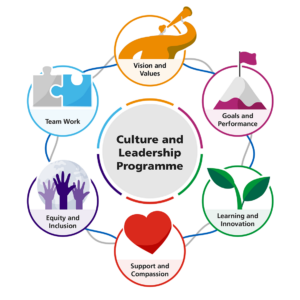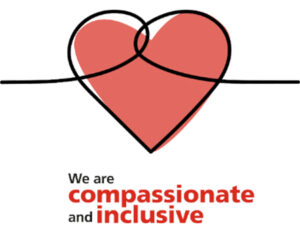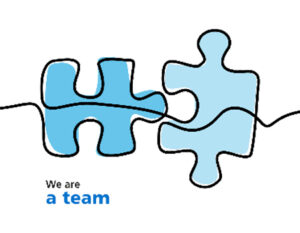How do I take action? Design Phase
 Now that you have an understanding of your current organisational culture, and how the leadership behaviours are perceived by colleagues, partners and the people we serve, the next step is to create a strategy to amplify the strengths, and take action to improve the weaker areas.
Now that you have an understanding of your current organisational culture, and how the leadership behaviours are perceived by colleagues, partners and the people we serve, the next step is to create a strategy to amplify the strengths, and take action to improve the weaker areas.
Designing a detailed leadership strategy should provide practical things you can do to develop compassionate inclusive leadership at all the different levels of the system: individual, team, organisational and integrated care system. Research evidence shows that congruence of behaviours and values is crucial for culture change to be sustained; people have to see them to believe them.
The Design Phase is another opportunity to role model a way of working which demonstrates collective leadership. For example, your change team might lead on the design of your Culture Strategy, but they might also engage colleagues across the organisation to co-design approaches and interventions. How you design your strategy is just as important as what it contains.
Also consider how you wish to prioritise the activity. Focusing on a small number of objectives that are achievable is preferable to having a wide range of objectives where some aren’t delivered. Attending to the needs of the most marginalised in your organisation demonstrates compassionate and inclusive leadership.
The approach, tools and guidance within the Culture and Leadership Programme are intended to support you and your colleagues to successfully transform the culture of your organisation, enabling you to create an environment where you can deliver on all aspects of the NHS People Promise.
 Please note: The Culture Transformation Team have been working to review and revise the Scoping Phase and Discovery Phase resources for this programme in order to incorporate recommendations from our independent evaluation and also make the connection with other strategic developments such as the People Promise. The Design Phase resources are included in the next phase of this work. Please therefore keep this in mind as you work through the documents. If you have any questions, please do not hesitate to get in touch with the team: england.culture@nhs.net.
Please note: The Culture Transformation Team have been working to review and revise the Scoping Phase and Discovery Phase resources for this programme in order to incorporate recommendations from our independent evaluation and also make the connection with other strategic developments such as the People Promise. The Design Phase resources are included in the next phase of this work. Please therefore keep this in mind as you work through the documents. If you have any questions, please do not hesitate to get in touch with the team: england.culture@nhs.net.
Guide
To support you as you explore the Design Phase of the Culture and Leadership Programme, we have created the Design phase guide. Whether you like to work your way through, dip in and out or have something to refer back to outside of a learning space, we hope this interactive document will enable you to access the resources you require quickly, and without having to read the entire document.
Design phase resources
- Example mapping of intelligence from Discovery Phase across five cultural elements. Please note: this resource is under revision to reflect the six cultural elements and the People Promise.
- Example Mapping current and future interventions against cultural elements. Please note: this resource is under revision to reflect the six cultural elements and the People Promise.
- Single Hospital Service (SHS) Organisation Development Plans. Please note: this resource is under revision to reflect the six cultural elements and the People Promise.
- Building trust and understanding with others. Please note: this resource is under revision to reflect the six cultural elements and the People Promise.
- Creating a vision for your change. Please note: this resource is under revision to reflect the six cultural elements and the People Promise.
Learning together
- Learning from others: How Northumbria Healthcare NHS Foundation Trust Involved the Change Team in their mapping work
- Learning from others: How Manchester University NHS Foundation Trust placed culture at the forefront of a merger to become a single hospital
- Learning from others: How Royal Bournemouth and Christchurch Hospitals NHS Foundation Trust moved from Design Phase to Delivery Phase
For more examples and resources, please visit our learning together pages.
Focused support
When you complete your synthesis after the Discovery Phase, you will likely identify one or two areas where you might need further specialist support or guidance. Here we have linked to some of the typical areas organisations focus on, as well as the nationally available resources. If you would like an introduction to any of the regional or national leads for these areas, please drop us a message: england.culture@nhs.net

Civility and respect
If you identify that interpersonal conflict, bullying or harassment is a particular issue for your organisation, or you would like to support colleagues to feel confident to speak up and address such potential conflict in the moment before it becomes a bigger issue, then you may find the resources on Civility and Respect helpful to support your strategy on a just culture and adopting restorative approaches to create cultures of civility and respect.

Freedom to speak up
Compassionate and inclusive cultures have an important part to play in creating the psychological safety needed to enable people to speak up to offer an alternative contribution or perspective, and importantly, to challenge or seek support when they have a concern. Freedom to speak up is a key enabler to creating safe routes to raise concerns. Tools and guides have been published on the freedom to speak up pages.

Health and wellbeing
Showing compassion to our colleagues by looking after the health and wellbeing of our NHS people is a fundamental priority for all healthcare organisations. All of the evidence shows that healthy employees lead to good quality care. The NHS Health and Wellbeing Framework is designed to help healthcare organisations to create a culture of wellbeing where all of their people can maintain and improve their wellbeing and pass this wellbeing onto our patients.
Leadership development
We know the number one driver of an organisation’s culture is leadership, both formal (based on role) and informal. The Leadership Academy have a suite of programmes and bitesized resources to support personal leadership development in your organisation. You may also wish to contact your Regional Leadership Academy for more localised support.

Flexible working
Flexible working can unlock new opportunities and positively contribute to people’s mental health, wellbeing and engagement with their role, and we know that in the NHS more engaged staff leads to better patient care. A growing collection of resources to help you to create a flexible working environment can be found on the flexible working pages.

Retention
Looking after our people and becoming an employer of excellence where our people are valued, supported, developed and invested in is a key priority across the NHS. Creating an working environment where colleagues can thrive and want to stay not only helps with retention, but also attraction. The ‘looking after our people – retention’ pages have resources, case studies and connections to regional support to help your focus on retention.
- Email: england.culture@nhs.net
- Twitter: @culture_nhs
Join the conversation with #OurNHSPeople and #WeAreTheNHS.
Sharing your stories
We’d love to hear your story too. Please join our Community of Practice or get in touch with the team: england.culture@nhs.net

